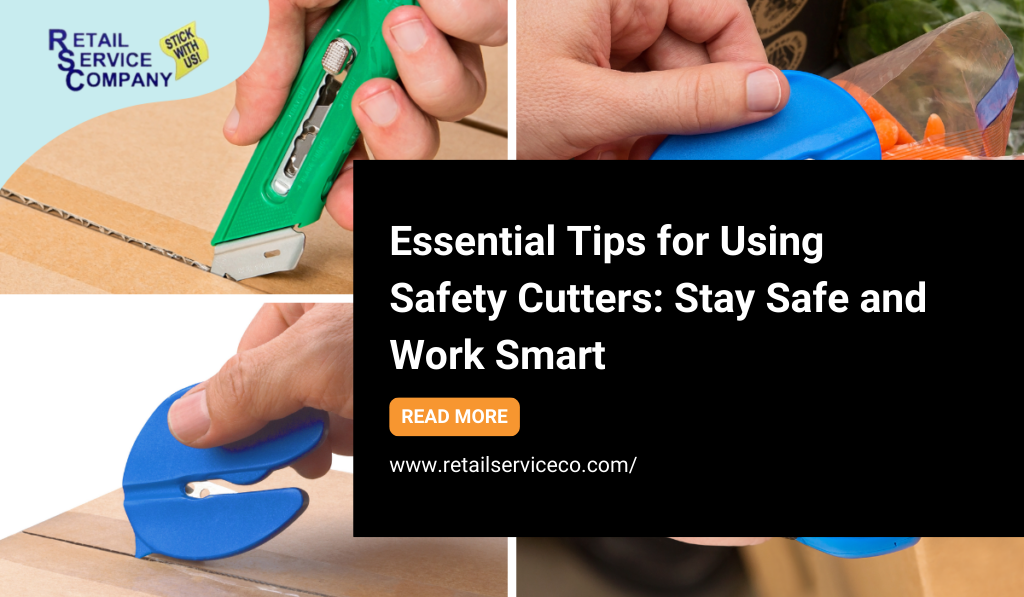
Essential Tips for Using Safety Cutters: Stay Safe and Work Smart
Safety cutters are helpful tools for cutting things like boxes, plastic, and more. You might use them at home, school, or work to get tasks done quickly. But remember, safety cutters are sharp tools, so using them the right way is important to avoid accidents. Here, we’ll go over some easy tips to help you stay safe while using safety cutters
Pick the Right Safety Cutter for the Job
Safety cutters come in different types, each made for specific tasks. Choosing the right one can make your work safer and easier.
- Disposable Cutters: Small and handy for quick tasks like opening packages.
- Retractable Blade Cutters: These cutters have blades that pull back automatically after you cut, helping to prevent accidents.
- Self-Retracting Cutters: These are even safer! The blade pulls back as soon as you release it, reducing the chance of cuts.
Check Your Safety Cutter Before Each Use
Before you start cutting, take a moment to inspect the cutter. A broken or dull blade can slip and cause injury. Here’s what to check:
- Sharpness: Make sure the blade is sharp. Dull blades need more force, which can lead to slips.
- Blade Retraction: Test if the blade pulls back smoothly.
- Handle Grip: Check for cracks or slipperiness; a secure grip is safer.
By checking your cutter each time, you’ll reduce the chance of accidents and keep your tool in good shape
Follow Proper Cutting Techniques
Using the correct cutting techniques can prevent most accidents:
- Cut Away from Your Body: Always direct the blade away from your body and fingers.
- Use Smooth Movements: Don’t rush. Slow, steady cuts are safer and more effective.
- Hold Material Steady: Keep the object you’re cutting still to avoid slips.
- Stay Focused: Avoid distractions when using a cutter; full attention is key.
These techniques help you work safely and efficiently with your cutter.
Wear Safety Gear
If you’re working on big projects or cutting tough materials, safety gear can add protection:
- Cut-Resistant Gloves: These gloves protect your hands from accidental cuts.
- Safety Glasses: If there’s a chance of debris or splinters, protect your eyes with glasses.
- Proper Shoes: If you’re in a workspace with heavy materials, wear sturdy shoes like steel-toed boots to protect your feet.
Wearing the right gear reduces the risk of injuries, especially when working with sharp tools.
Store Your Safety Cutter Properly
When you’re done with the cutter, store it safely to avoid accidents:
- Retract the Blade: Always pull the blade back before putting the cutter away.
- Keep Out of Reach of Children: Store the cutter in a place where kids can’t reach it.
- Use a Designated Spot: Keep it in a toolbox or drawer so it doesn’t get misplaced.
Good storage practices protect everyone around you and help extend the cutter’s life.
Get Proper Training on Using Safety Cutters
If you’re working with others, like in a warehouse, make sure everyone knows how to use safety cutters properly:
- Teach Safe Cutting Techniques: Show others how to use the tool safely.
- Check Tools Regularly: Teach everyone to inspect their cutters to ensure they’re in good condition.
- Use Protective Gear: Encourage the right safety gear for different tasks.
Training keeps everyone on the same page about safety.
Replace Dull Blades Regularly
Dull blades are dangerous because they require extra force, increasing the chance of slips. Here’s what to do:
- Check for Dullness: If the blade struggles to cut smoothly, it’s time to replace it.
- Easy Blade Replacement: Many safety cutters have easy-to-replace blades, so change them when needed.
Regular blade replacements keep the tool working well and prevent accidents.
Know Your Cutter’s Limits
Safety cutters are made for specific materials. If you try to cut something too thick or hard, you can damage the cutter or injure yourself. If you need to cut thicker items like rubber or metal, choose a cutter designed for heavy-duty tasks.
Using the right cutter for the job helps you stay safe and protects your tool from breaking.
Conclusion
Safety cutters are useful tools, but they need to be used carefully. By choosing the right cutter, checking it before each use, following safe cutting techniques, wearing protective gear, and storing it properly, you can work safely and efficiently. Always remember that safety comes first!

